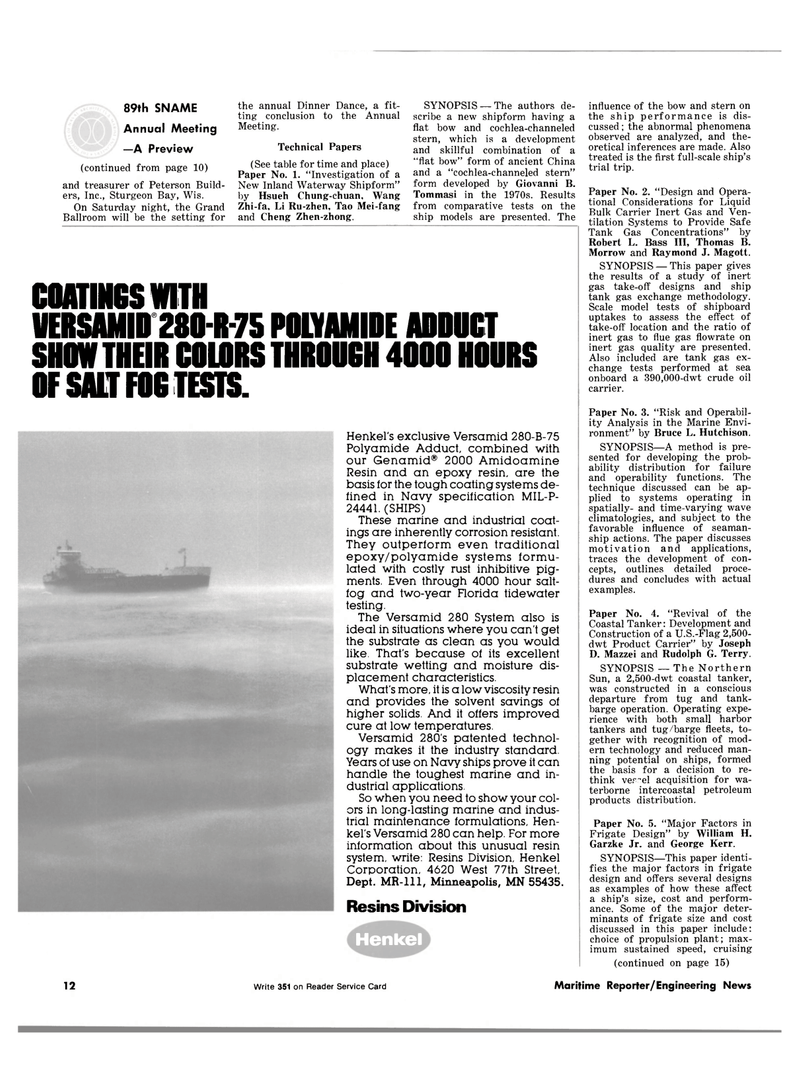
Page 10: of Maritime Reporter Magazine (November 1981)
Read this page in Pdf, Flash or Html5 edition of November 1981 Maritime Reporter Magazine
89th SNAME
Annual Meeting —A Preview (continued from page 10) and treasurer of Peterson Build- ers, Inc., Sturgeon Bay, Wis.
On Saturday night, the Grand
Ballroom will be the setting for the annual Dinner Dance, a fit- ting conclusion to the Annual
Meeting.
Technical Papers (See table for time and place)
Paper No. 1. "Investigation of a
New Inland Waterway Shipform" by Hsueh Chung-chuan, Wang
Zhi-fa, Li Ru-zhen, Tao Mei-fang and Cheng Zhen-zhong.
SYNOPSIS —The authors de- scribe a new shipform having a flat bow and cochlea-channeled stern, which is a development and skillful combination of a "flat bow" form of ancient China and a "cochlea-channeled stern" form developed by Giovanni B.
Tommasi in the 1970s. Results from comparative tests on the ship models are presented. The
COATINGS WITH
VERSAMID 280-R-75 POLYAMIDE ADDUCT
SHOW THEIR COIORS THROUGH 4000 HOURS
OF SALT FOG TESTS.
Henkel's exclusive Versamid 280-B-75
Polyamide Adduct, combined with our Genamid® 2000 Amidoamine
Resin and an epoxy resin, are the basis for the tough coating systems de- fined in Navy specification MIL-P- 24441. (SHIPS)
These marine and industrial coat- ings are inherently corrosion resistant.
They outperform even traditional epoxy/polyamide systems formu- lated with costly rust inhibitive pig- ments. Even through 4000 hour salt- fog and two-year Florida tidewater testing.
The Versamid 280 System also is ideal in situations where you can't get the substrate as clean as you would like. That's because of its excellent substrate wetting and moisture dis- placement characteristics.
What's more, it is a low viscosity resin and provides the solvent savings of higher solids. And it offers improved cure at low temperatures.
Versamid 280's patented technol- ogy makes it the industry standard.
Years of use on Navy ships prove it can handle the toughest marine and in- dustrial applications.
So when you need to show your col- ors in long-lasting marine and indus- trial maintenance formulations, Hen- kel's Versamid 280 can help. For more information about this unusual resin system, write: Resins Division, Henkel
Corporation, 4620 West 77th Street,
Dept. MR-111, Minneapolis, MN 55435.
Resins Division
Henkel influence of the bow and stern on the ship performance is dis- cussed ; the abnormal phenomena observed are analyzed, and the- oretical inferences are made. Also treated is the first full-scale ship's trial trip.
Paper No. 2. "Design and Opera- tional Considerations for Liquid
Bulk Carrier Inert Gas and Ven- tilation Systems to Provide Safe
Tank Gas Concentrations" by
Robert L. Bass III, Thomas B.
Morrow and Raymond J. Magott.
SYNOPSIS — This paper gives the results of a study of inert gas take-off designs and ship tank gas exchange methodology.
Scale model tests of shipboard uptakes to assess the effect of take-off location and the ratio of inert gas to flue gas flowrate on inert gas quality are presented.
Also included are tank gas ex- change tests performed at sea onboard a 390,000-dwt crude oil carrier.
Paper No. 3. "Risk and Operabil- ity Analysis in the Marine Envi- ronment" by Bruce L. Hutchison.
SYNOPSIS—A method is pre- sented for developing the prob- ability distribution for failure and operability functions. The technique discussed can be ap- plied to systems operating in spatially- and time-varying wave climatologies, and subject to the favorable influence of seaman- ship actions. The paper discusses motivation and applications, traces the development of con- cepts, outlines detailed proce- dures and concludes with actual examples.
Paper No. 4. "Revival of the
Coastal Tanker: Development and
Construction of a U.S.-Flag 2,500- dwt Product Carrier" by Joseph
D. Mazzei and Rudolph G. Terry.
SYNOPSIS — The Northern
Sun, a 2,500-dwt coastal tanker, was constructed in a conscious departure from tug and tank- barge operation. Operating expe- rience with both small harbor tankers and tug/barge fleets, to- gether with recognition of mod- ern technology and reduced man- ning potential on ships, formed the basis for a decision to re- think ver^el acquisition for wa- terborne intercoastal petroleum products distribution.
Paper No. 5. "Major Factors in
Frigate Design" by William H.
Garzke Jr. and George Kerr.
SYNOPSIS—This paper identi- fies the major factors in frigate design and offers several designs as examples of how these affect a ship's size, cost and perform- ance. Some of the major deter- minants of frigate size and cost discussed in this paper include: choice of propulsion plant; max- imum sustained speed, cruising (continued on page 15) 12 Write 351 on Reader Service Card Maritime Reporter/Engineering News

 9
9

 11
11
